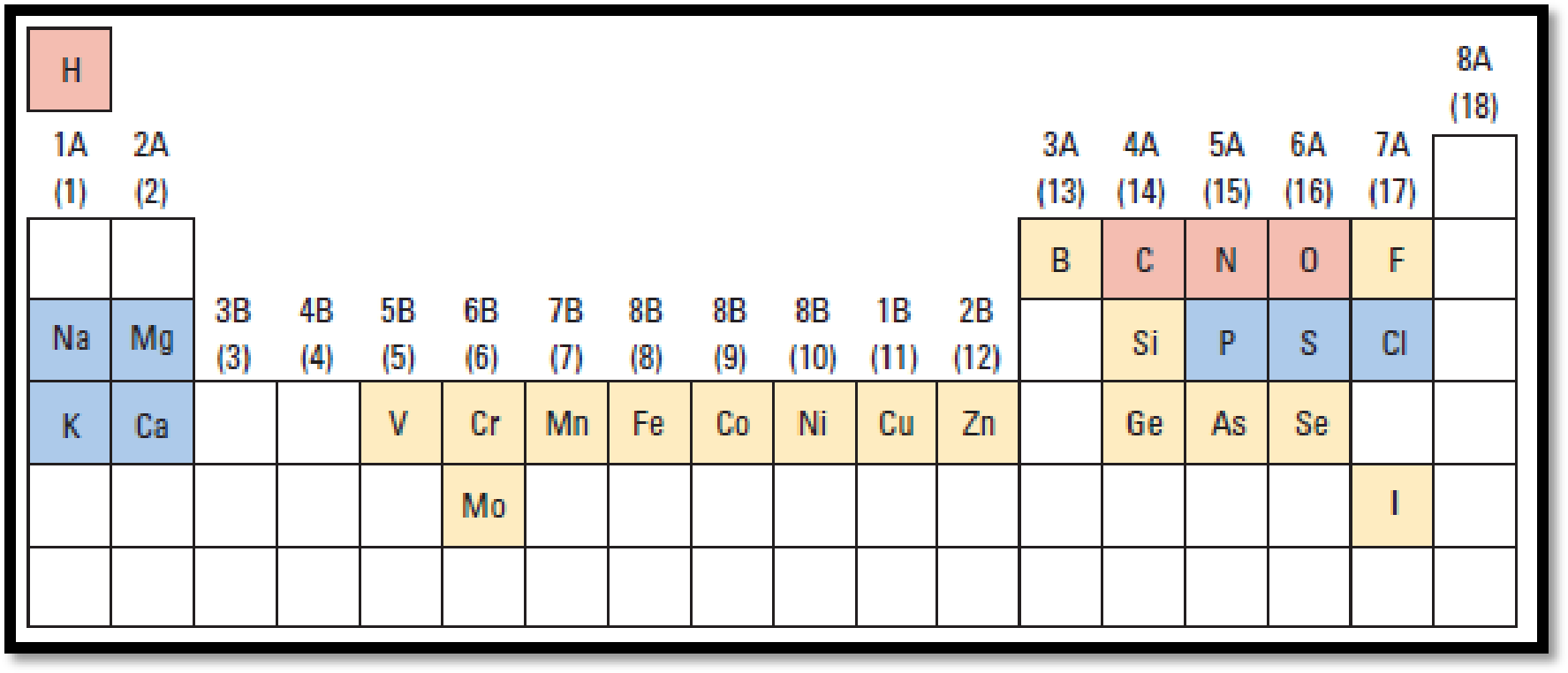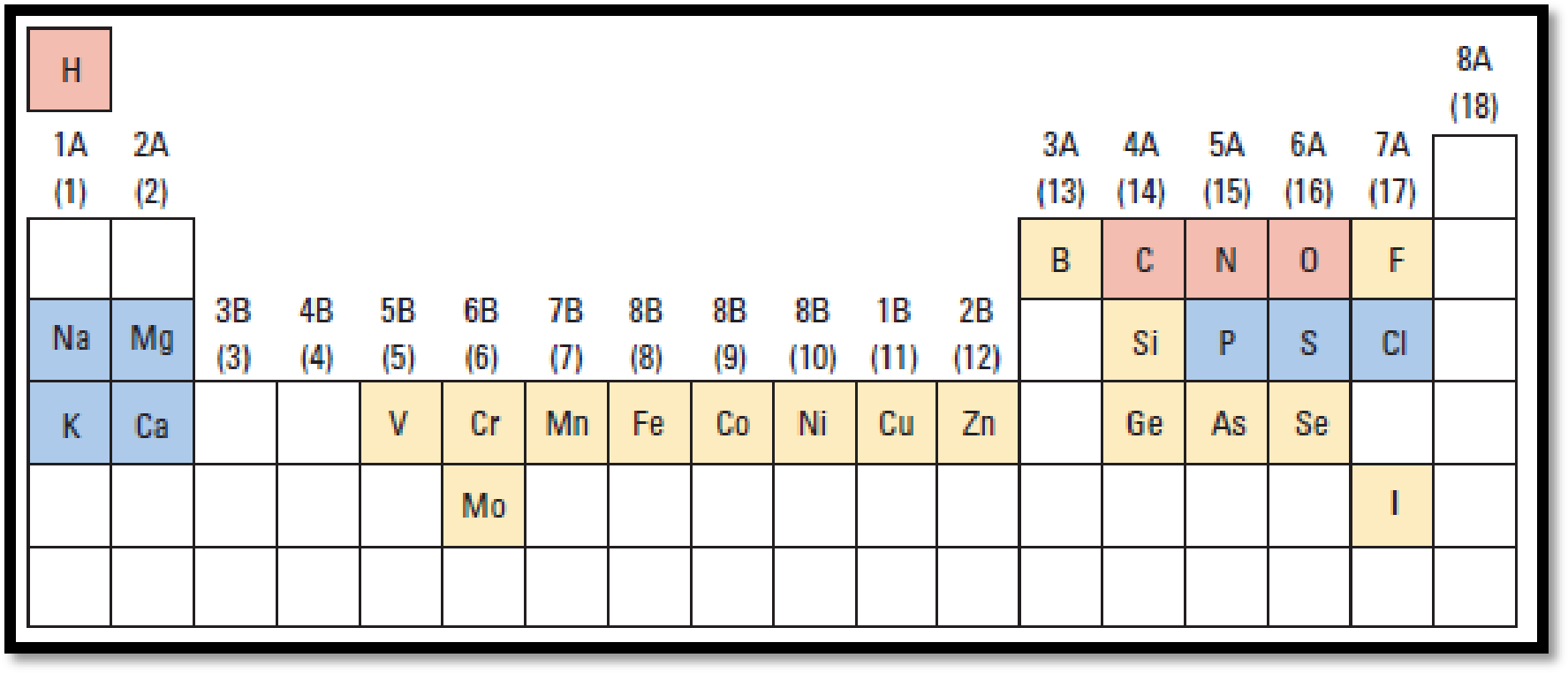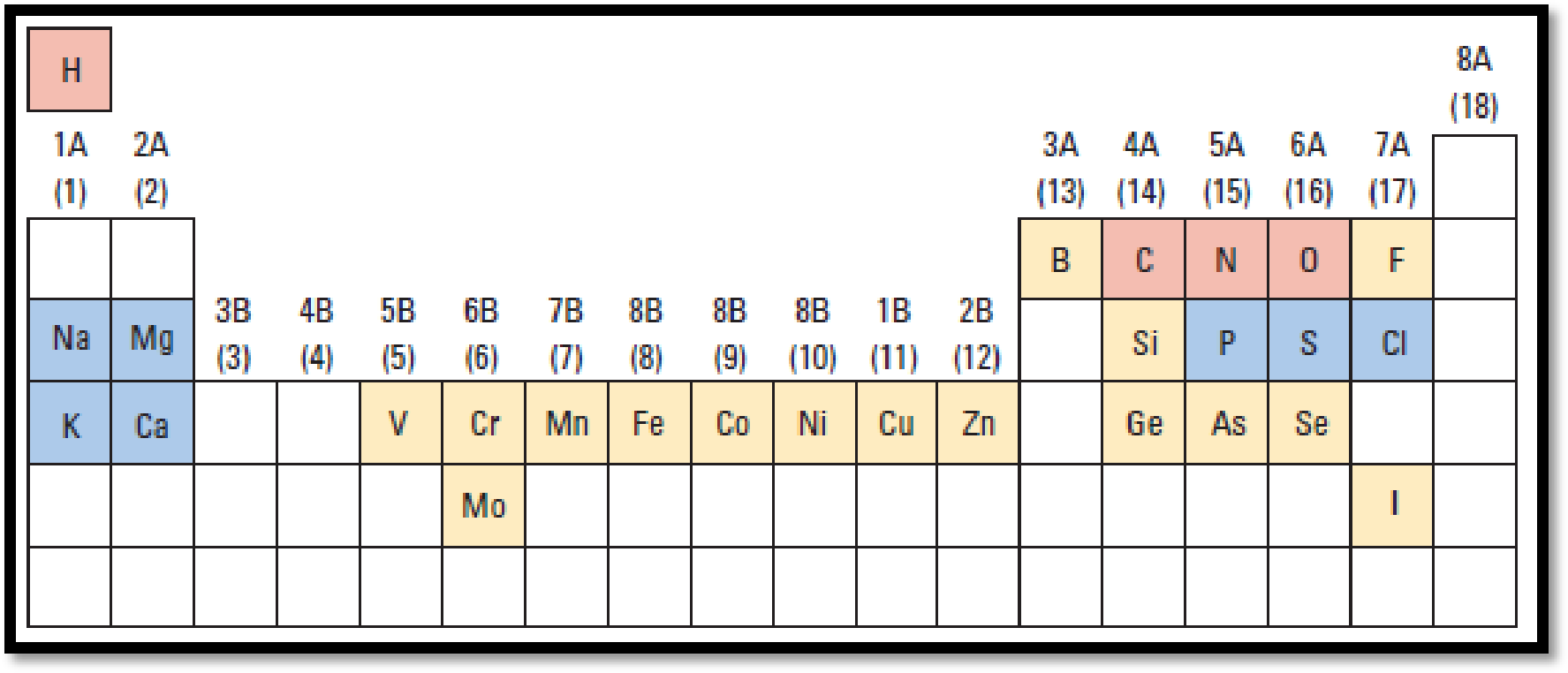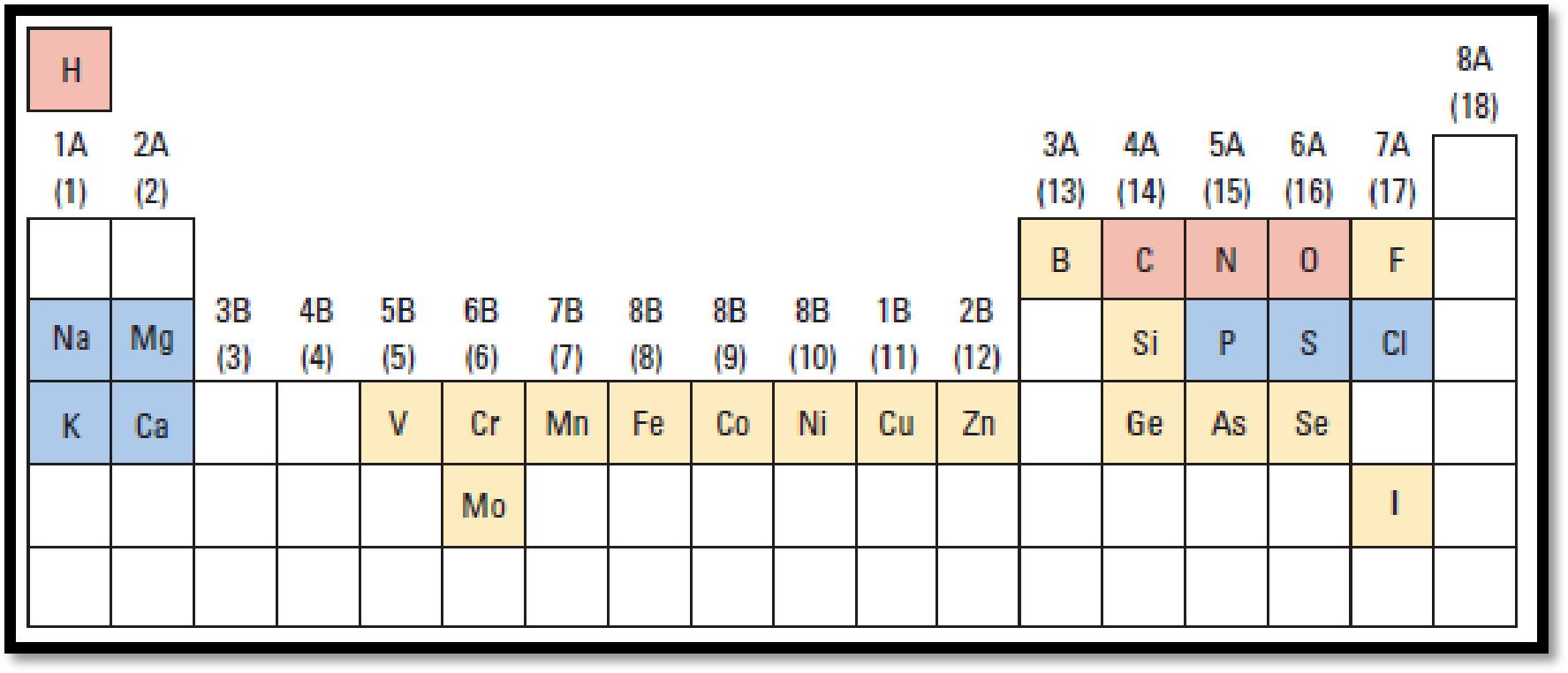
Chemistry: The Molecular Science
5th Edition
ISBN: 9781285199047
Author: John W. Moore, Conrad L. Stanitski
Publisher: Cengage Learning
expand_more
expand_more
format_list_bulleted
Question
Chapter 1.14, Problem 1.13E
(a)
Interpretation Introduction
Interpretation:
Using the given figure, the essential nonmetals has to be identified.

Figure 1
(b)
Interpretation Introduction
Interpretation:
Using the given figure, the essential alkaline-earth metals has to be identified.

Figure 1
(c)
Interpretation Introduction
Interpretation:
Using the given figure, the essential halide ions has to be identified.

Figure 1
(d)
Interpretation Introduction
Interpretation:
Using the given figure, four essential

Figure 1
Expert Solution & Answer
Want to see the full answer?
Check out a sample textbook solution
Students have asked these similar questions
Predict the major products of this organic reaction:
HBr (1 equiv)
cold
?
Some important notes:
• Draw the major product, or products, of this reaction in the drawing area below.
• You can draw the products in any arrangement you like.
• Pay careful attention to the reaction conditions, and only include the major products.
• Be sure to use wedge and dash bonds when necessary, for example to distinguish between major products that are enantiomers.
• Note that there is only 1 equivalent of HBr reactant, so you need not consider the case of multiple additions.
Erase something
Explanation
Check
2025 McGraw Hill LLC. All Rights Reserved. Ter
Q14. Fill this chart: (please refer to ppt notes/browser to answer these questions)
What alcohol is also called wood alcohol?
What is the common name of ethanol?
Draw the structure of phenol and thiophene?
Are bigger chain alcohol like heptanol and octanol
are soluble or insoluble in water and explain it ?
Are ethers soluble or insoluble in water?
What suffix and prefix are used for alcohol while
naming alcohol and ether?
What the process called when we add water to any
alkene to make alcohol?
Q16. Draw the diagram of following aromatic compound (practice from previous module)
Aniline
Phenol
Benzoic acid
Methyl benzoate
Q17. a. Write the oxidation reactions for the 2 propanol.
b. Write the oxidation reaction of the ethanol.
Question 11 of 18 (1 point) Question Attempt: 3 of
How many signals do you expect in the 'H NMR spectrum for this molecule?
Br
Br
Write the answer below.
Also, in each of the drawing areas below is a copy of the molecule, with Hs shown. In each copy, one of the H atoms is colored red. Highlight in red all other H
atoms that would contribute to the same signal as the H already highlighted red.
Note for advanced students: In this question, any multiplet is counted as one signal.
Number of signals in the 'H NMR spectrum.
1
For the molecule in the top drawing area, highlight in red any other H atoms that will contribute to
the same signal as the H atom already highlighted red.
If no other H atoms will contribute, check the box at right.
No additional Hs to color in top
molecule
Check
For the molecule in the bottom drawing area, highlight in red any other H atoms that will contribute
to the same signal as the H atom already highlighted red.
If no other H atoms will contribute, check the box…
Chapter 1 Solutions
Chemistry: The Molecular Science
Ch. 1.4 - Temperature
Determine which temperature is higher,...Ch. 1.4 - Prob. 1.2CECh. 1.4 - Identify each physical property and physical...Ch. 1.5 - SI Units and Prefixes
Show mathematically that 1...Ch. 1.5 - Prob. 1.5ECh. 1.5 - Calculate the volume occupied by a 4.33-g sample...Ch. 1.6 - Identify the chemical and physical changes that...Ch. 1.8 - Prob. 1.2PSPCh. 1.8 - Prob. 1.7ECh. 1.9 - Prob. 1.8CE
Ch. 1.11 - Draw a nanoscale representation and a symbolic...Ch. 1.13 - Prob. 1.9ECh. 1.13 - Prob. 1.10ECh. 1.13 - Prob. 1.11ECh. 1.13 - Prob. 1.12ECh. 1.14 - Prob. 1.13ECh. 1 - Prob. 1QRTCh. 1 - Choose an object in your room, such as a cell...Ch. 1 - Prob. 3QRTCh. 1 - Prob. 4QRTCh. 1 - Prob. 5QRTCh. 1 - Prob. 6QRTCh. 1 - Which of these statements are qualitative? Which...Ch. 1 - Which of the these statements are qualitative?...Ch. 1 - The elements sulfur and bromine are shown in the...Ch. 1 - In the accompanying photo, you see a crystal of...Ch. 1 - Prob. 13QRTCh. 1 - Prob. 14QRTCh. 1 - Prob. 15QRTCh. 1 - Suppose a room is 18 m long, 15 m wide, and the...Ch. 1 - Prob. 17QRTCh. 1 - Prob. 18QRTCh. 1 - Prob. 19QRTCh. 1 - Prob. 20QRTCh. 1 - Perform these calculations and express the result...Ch. 1 - Prob. 22QRTCh. 1 - A 105.5-g sample of a metal was placed into water...Ch. 1 - Prob. 24QRTCh. 1 - An unknown sample of a metal is 1.0 cm thick, 2.0...Ch. 1 - Calculate the volume of a 23.4-g sample of...Ch. 1 - Calculate the mass of a sodium chloride crystal if...Ch. 1 - Calculate the volume occupied by a 4.33-g sample...Ch. 1 - In each case, identify the italicized property as...Ch. 1 - Prob. 30QRTCh. 1 - In each case, describe the change as a chemical or...Ch. 1 - In each case, describe the change as a chemical or...Ch. 1 - Prob. 33QRTCh. 1 - Prob. 34QRTCh. 1 - Prob. 35QRTCh. 1 - Identify each of these as a homogeneous or a...Ch. 1 - Devise and describe an experiment to (a) Separate...Ch. 1 - Prob. 38QRTCh. 1 - For each of the changes described, decide whether...Ch. 1 - For each of the changes described, decide whether...Ch. 1 - Classify each of these as an element, a compound,...Ch. 1 - Prob. 42QRTCh. 1 - Prob. 43QRTCh. 1 - Prob. 44QRTCh. 1 - Prob. 45QRTCh. 1 - Prob. 46QRTCh. 1 - Prob. 47QRTCh. 1 - Prob. 48QRTCh. 1 - Prob. 49QRTCh. 1 - Prob. 50QRTCh. 1 - Prob. 51QRTCh. 1 - Prob. 52QRTCh. 1 - Prob. 53QRTCh. 1 - Prob. 54QRTCh. 1 - Write a chemical formula for each substance, and...Ch. 1 - Prob. 56QRTCh. 1 - Prob. 57QRTCh. 1 - Prob. 58QRTCh. 1 - Prob. 59QRTCh. 1 - Prob. 60QRTCh. 1 - Prob. 61QRTCh. 1 - Prob. 62QRTCh. 1 - Name and give symbols for three transition metals...Ch. 1 - Name two halogens. Look up each of your choices in...Ch. 1 - Prob. 65QRTCh. 1 - Prob. 66QRTCh. 1 - Prob. 67QRTCh. 1 - Prob. 68QRTCh. 1 - Prob. 69QRTCh. 1 - Prob. 70QRTCh. 1 - Prob. 71QRTCh. 1 - Prob. 72QRTCh. 1 - Prob. 73QRTCh. 1 - Prob. 74QRTCh. 1 - Prob. 75QRTCh. 1 - Prob. 76QRTCh. 1 - The label on a bale of mulch indicates a volume of...Ch. 1 - Prob. 78QRTCh. 1 - Prob. 79QRTCh. 1 - The cancer drug cisplatin contains 65.0% platinum....Ch. 1 - Prob. 81QRTCh. 1 - The density of gaseous helium at 25 C and normal...Ch. 1 - Prob. 83QRTCh. 1 - Prob. 84QRTCh. 1 - Prob. 85QRTCh. 1 - You can figure out whether a substance floats or...Ch. 1 - Prob. 87QRTCh. 1 - Prob. 88QRTCh. 1 - Prob. 89QRTCh. 1 - Prob. 90QRTCh. 1 - Prob. 91QRTCh. 1 - Which two elements from this list exhibit the...Ch. 1 - Prob. 93QRTCh. 1 - Prob. 94QRTCh. 1 - Prob. 95QRTCh. 1 - Prob. 96QRTCh. 1 - Prob. 97QRTCh. 1 - Prob. 98QRTCh. 1 - Prob. 99QRTCh. 1 - Using Table 1.1, but without using your...Ch. 1 - Prob. 101QRTCh. 1 - At 25 C the density of water is 0.997 g/mL,...Ch. 1 - Prob. 103QRTCh. 1 - Prob. 104QRTCh. 1 - Prob. 105QRTCh. 1 - Prob. 106QRTCh. 1 - Answer these questions using figures (a) through...Ch. 1 - Prob. 108QRTCh. 1 - Prob. 109QRTCh. 1 - Prob. 110QRTCh. 1 - Prob. 111QRTCh. 1 - Prob. 112QRTCh. 1 - Prob. 113QRTCh. 1 - Prob. 114QRTCh. 1 - Prob. 115QRTCh. 1 - Prob. 116QRTCh. 1 - Prob. 118QRTCh. 1 - Prob. 119QRTCh. 1 - Prob. 120QRTCh. 1 - Prob. 121QRTCh. 1 - Prob. 122QRTCh. 1 - The element magnesium reacts with the element...Ch. 1 - Prob. 124QRTCh. 1 - Prob. 125QRTCh. 1 - When 12.6 g calcium carbonate (the principal...Ch. 1 - Prob. 127QRTCh. 1 - Suppose you are trying to get lemon juice and you...Ch. 1 - Prob. 1.BCPCh. 1 - Prob. 1.CCPCh. 1 - Prob. 1.DCPCh. 1 - Prob. 1.ECPCh. 1 - Some scientists think there are living things...Ch. 1 - Prob. 1.GCPCh. 1 - Prob. 1.HCP
Knowledge Booster
Learn more about
Need a deep-dive on the concept behind this application? Look no further. Learn more about this topic, chemistry and related others by exploring similar questions and additional content below.Similar questions
- Organic Chemistry Esterification reactions 1. Write the steps to prepare ester. 2. Write complete reaction of ethanol and acetic acid to make ester. 3. What does ester smell like? What are the uses of ester. 4. What the role of sulfuric acid in the esterification reactionarrow_forward11. Complete the following esterification reaction with names of all the reactants and products under. Hint: Remove the water and end up with ester R-C-OH + ROH R-C-OR + H₂O A carboxylic acid An alcohol An ester Water BYJU'S H-C-C O-H Нин C-C-C-H HAAA H O-C-C-C-H AAA Ethanoic acid Propanol Water Propyl ethanoate By com CH3COOH + CH3CH2CH2CH₂CH₂OH → Practice for alcohols aldehydes and ketones: 12. Draw the structures from the following names mixed of alcohol/aldehyde and ketone: a. 4-methyl cyclohexanone b. 3-methyl-2-pentenal c. 2,3-dimethylcyclohexanone d. 1,3propanediol or Propane 1,3 diol 13. Write systematic names for the following compounds identify functional group: a. b. (CH3)2CH-C OH c) CH(CH₂)-- OH -,-,arrow_forwardmay you please show all steps! i am having a hard time understanding and applying in this format, thank you!arrow_forward
- 10. Complete the substitution reaction of 2 pentanol with these reagents. Reagents & Reaction Conditions use practice sheet. Please write only major products, minor product like water, other gases are not required. Hint: In substitution of alcohol, we generally substitute OH group with Halogens like cl, Br, F using some reagent containing halogens. Ensure to add halogens to the same carbon number where you are removing OH from Examples Alcohols can be converted to Alkyl Halides with HX acids HBr H₂O HCI + H₂O HI + H₂O CH,CH₂OH + SOCI₂ CH,CH₂OH + PCI₁₂ A BBYJU'S CH CHCI + SO₂+ HCI CH₂CH CIP(OH), + HCI CH,CH₂OH + PCI CHCHCI + POCI + HCI CH,CH₂OH + PBr, CH,CH,Br + P(OH), + HBr 1. Reaction with HBr with 2 Pentanol 2.Reaction with HI with 2 pentanol © Byjus.com 3.Reaction with HCI+ZnCl,, with 2 pentanol (Zncl2 is catalyst no role) 4.Reaction with SOCI,, with 2 Pentanol 5.Reaction with PBr; or PCl, with 2 pentanolarrow_forward3. Is 2-methyl-2-propanol a primary, secondary, or tertiary alcohol? Write out the structures of 2-methyl-2-propanol and also any oxidation products of 2- methyl-2- propanol. If there is more than one oxidation product, give the structure of each of the products. 4. 2-Propanol is the IUPAC systematic name of this alcohol. It has a common name by which it is much better known (You'll see it in the grocery store or pharmacy). Give that common name 5. Aldehydes can be synthesized by the oxidation of. Please choose from below choices A. Primary alcohols B. Secondary alcohols C. Organic acids D. Inorganic acids 6. Tertiary alcohol Can undergo oxidation. yes or no. ? If yes then answer the product.arrow_forwardFinish the reactions hand written pleasearrow_forward
- Part A Identify each alcohol as primary, secondary, or tertiary Drag the appropriate items to their respective bins. CH₂ H₂C- -C-OH HO CH₂ Primary Он OH CH₂ OH CCH₂OH CH₂ сн Secondary Tertiary Reset Help CH,CH₂ (CH)CHCH,OH CH,CH,CH,CCH, CHOH CH₂ Different types of alcohol groups Alcohol and its reaction: 8. Combing two alcohol molecules below and completing the reaction with Product .( Hint Reaction called etherification as ether is formed and name the ether once you complete the reaction. Hint.: R-O-H+H-O-RR-O-R Do the reaction: CH₂OH + CH₂OH---→ + H-O-H 9. Write the reaction of formation of alcohol from alkene by adding water: Addition reaction also called hydration reaction as we are adding water which occur always in presence of acid Hint: Break the double bond and add H and OH if symmetrical then add anywhere if unsymmetrical then follow Markovnikov rule H should go to that double bone carbon which has more hydrogen CH2=CH2 + H₂O-→arrow_forwardComplete the reaction hand written pleasearrow_forwardPredict the major products of this organic reaction: HBr (1 equiv) cold ? Some important notes: • Draw the major product, or products, of this reaction in the drawing area below. • You can draw the products in any arrangement you like. • Pay careful attention to the reaction conditions, and only include the major products. • Be sure to use wedge and dash bonds when necessary, for example to distinguish between major products that are enantiomers. • Note that there is only 1 equivalent of HBr reactant, so you need not consider the case of multiple additions. dm Re Explanation Check ©2025 McGraw Hill LLC. All Rights Reserved. Termarrow_forward
- b) Use curved arrows to show the reaction of the radical with hydrogen bromide. Br: Br H .. Answer Bankarrow_forwardIndicate the reaction products when CH3COCH2COOCH2COOC2H5 (ethyl acetoacetoacetate) reacts with 1º OH-/H2O and 2º H3O+arrow_forwardDraw the formula of the compound 4-cyclohexyl butanamide?arrow_forward
arrow_back_ios
SEE MORE QUESTIONS
arrow_forward_ios
Recommended textbooks for you

Chemistry
Chemistry
ISBN:9781305957404
Author:Steven S. Zumdahl, Susan A. Zumdahl, Donald J. DeCoste
Publisher:Cengage Learning

What are CHNOPS? These Chemical Elements = 98% of Life | Biology | Biochemistry; Author: Socratica;https://www.youtube.com/watch?v=w90wFlR53VM;License: Standard YouTube License, CC-BY